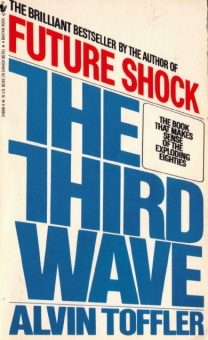THE THIRD WAVE
This centrally produced imagery, injected into the “mass mind” by the mass media; helped produce the standardization of behavior required by the Industrial production system.
Today the Third Wave is drastically altering all this. As change accelerates in society it forces a parallel acceleration within us. New information reaches us and we are forced to revise our image-file continuously at a faster and faster rate. Older images based on past reality must be replaced, for, unless we update them, our actions become divorced from reality and we become progressively less competent. We find it impossible to cope.
This speedup of image processing inside «s means that images grow mqre and more empnrary Thrnwawav art, one-shot sitcoms, Polaroid snapshots, Xerox copies, and disposable graphics pop up and vanish. Ideas, beliefs, and attitudes skyrocket into consciousness, are challenged, defied, and suddenly fade into nowhere-ness; Scientific and psychological theories are overthrown and superseded daily.Ideologies crack. Celebrities pirouette fleetingly across our awareness. Contradictory political and moral slogans assail us.
It is difficult to make sense of this swirling phantasmagoria, to understand exactly how the image-manufacturing process is changing. For the Third Wave does more than simply accelerate our information flows: it transforms the deep structure of information on which our daily actions depend.
THE DE-MASSIFIED MEDIA
Throughout the Second Wave era the mass media grew more and more powerful. Today a startling change is taking place. As the Third Wave thunders in, the mass media, far from expanding their influence, are suddenly being forced to share it. They are being beaten back on many fronts at once by what I call the “de-massified media.”
Newspapers provide the first example. The oldest of the Second Wave’mass media, newspapers are losing their readers. By 1973 U.S. newspapers had reached a combined aggregate circulation of 63 million copies daily. Since 1973, however, instead of adding circulation, they have begun to lose it. By 1978 the total had declined to 62 million and worse was in store. The percentage of Americans who read a paper every day also fell, from 69 percent in 1972 to 62 per-
159
Pages: 1 2 3 4 5 6 7 8 9 10 11 12 13 14 15 16 17 18 19 20 21 22 23 24 25 26 27 28 29 30 31 32 33 34 35 36 37 38 39 40 41 42 43 44 45 46 47 48 49 50 51 52 53 54 55 56 57 58 59 60 61 62 63 64 65 66 67 68 69 70 71 72 73 74 75 76 77 78 79 80 81 82 83 84 85 86 87 88 89 90 91 92 93 94 95 96 97 98 99 100 101 102 103 104 105 106 107 108 109 110 111 112 113 114 115 116 117 118 119 120 121 122 123 124 125 126 127 128 129 130 131 132 133 134 135 136 137 138 139 140 141 142 143 144 145 146 147 148 149 150 151 152 153 154 155 156 157 158 159 160 161 162 163 164 165 166 167 168 169 170 171 172 173 174 175 176 177 178 179 180 181 182 183 184 185 186 187 188 189 190 191 192 193 194 195 196 197 198 199 200 201 202 203 204 205 206 207 208 209 210 211 212 213 214 215 216 217 218 219 220 221 222 223 224 225 226 227 228 229 230 231 232 233 234 235 236 237 238 239 240 241 242 243 244 245 246 247 248 249 250 251 252 253 254 255 256 257 258 259 260 261 262 263 264 265 266 267 268 269 270 271 272 273 274 275 276 277 278 279 280 281 282 283 284 285 286 287 288 289 290 291 292 293 294 295 296 297 298 299 300 301 302 303 304 305 306 307 308 309 310 311 312 313 314 315 316 317 318 319 320 321 322 323 324 325 326 327 328 329 330 331 332 333 334 335 336 337 338 339 340 341 342 343 344 345 346 347 348 349 350 351 352 353 354 355 356 357 358 359 360 361 362 363 364 365 366 367 368 369 370 371 372 373 374 375 376 377 378 379 380 381 382 383 384 385 386 387 388 389 390 391 392 393 394 395 396 397 398 399 400 401 402 403 404 405 406 407 408 409 410 411 412 413 414 415 416 417 418 419 420 421 422 423 424 425 426 427 428 429 430



